Archive for the ‘Search Engines’ Category
Description of ‘Search Engines’ Category:
Posts about news regarding Search Engine and search evolution.
Thursday, August 23rd, 2012
The Land of the Penguin, Everything is Black and White
Over the past year or so, Google has pushed some major changes in the form of an algorithmic update called Penguin (and just before it, another called Panda) that had a pretty single-minded purpose; to draw a line in the sand and call everything on the wrong side of the line ‘black’. Penguin actually changed almost nothing about the rules of good website marketing (though Panda did) — Penguin’s (very nearly) single purpose was to punish specific kinds of link-building behavior.
Google refers to the links it punishes as “questionable”. According to the law of the Penguin, a “questionable” link is one that:
- Has anchor text that is an exact match to the anchor text in the majority of your incoming links, particularly if the content that is linking is low-quality content.
- The link comes from an auto-approve, non-moderated blog — again, particularly if the content on that blog is of lower-than-average quality.
- OR, the link comes from a web site that has a significant number of outgoing links and no real traffic to speak of. (BuildMyRank, anyone? BuildMyRank deindexed)
These things seem relatively banal and minor, but if you’re a Search Engine Optimization (SEO) wonk, you’re already wincing. You can see between the lines that most links that may have been the SEO-baseline before Penguin are now out:
- Autoblogs? Nope.
- Site directories that few people use (i.e. a lot of them)? Useless.
- Even ubiquitous SEO toolbox items like optimizing for a specific keyword on each page got hit
- now you must spread your keywords around on every page or you’re flirting with the Google sandbox.
Paradigm Shift
The result of the Panda / Penguin double-punch has been profound across the field of SEO. It’s no longer about ranking as high as you can, as quickly as you can. It’s not even about deep research into your competitor’s backlink structure so that you can out-backlink them in an Olympic-style speed-back-linking event. (If you did SEO… Read the rest
Tags: Google, google penguin, seo
Posted in Google, Search Engine Optimization SEO | 2 Comments »
Monday, August 6th, 2012

Not that long ago, it wasn’t all that difficult to optimize a website for a search engine. Before there was Penguin or Panda, there was color. Or rather, there were shades of gray – areas that weren’t quite white-hat but weren’t black-hat enough for Google to penalize you for using them.
SEO wasn’t easy, per se, but it was easier.
The rules were more simple:
- Post decent content.
- Optimize your content for high-traffic, low-competition keywords with selling connotations.
- Don’t use obvious black-hat techniques like link-bombing.
- Build backlinks to your website. The more the better.
- Pack your keywords as dense as Google will let you (about 2% for most niches).
There were obviously details for each of these rules, but by and large, you could become an ‘SEO expert’ in a matter of weeks if you dedicated yourself to learning them. It might take a while to actually optimize a website, but it could actually be done by a single person working just a little overtime full time for a few weeks.
The most difficult parts of ‘old style’ SEO were producing content, some folks even outsourcing to writers off shore, like in India and the Philippines that spoke (or rather wrote) English just well enough to get Google to understand what they intended their topic to be. You could outsource an article overseas, and while with most of this content any English-speaking human that read it would laugh and click away, the search engine spiders didn’t mind the off syntax, so it worked.
Link-building was largely a matter of using automated systems that could mass-produce backlinks for you and hiring more outsourced link-builders to create those links that couldn’t be automated. SEO companies in the US often did the ‘hard’ work of producing quality content – the pieces that you expected people to read and that you put your company logo on – while they outsourced other content.
Then along came Penguin and before that its older brother Panda, and everything changed. Since we’re going to focus specifically on the Penguin update next week, let’s do a little bit of ‘in-between’; the… Read the rest
Tags: seo
Posted in Google, Search Engine Optimization SEO, Search Engines | 2 Comments »
Thursday, July 28th, 2011
Meta tags are special HTML tags that contain information or Meta data that is readable by browsers, search engines and other programs. Meta data is commonly referred to as “data about data”. It is documented information about a specific set of data and is essentially used to describe the contents of a webpage. Meta tags only contain page information, they do not change the appearance of the page. These tags are placed in the heading section of HTML code and are only visible to users when viewing the source page. The following is how Meta tags appear in a website’s source code.
<HEAD>
<TITLE>How to Create a Meta Tag</TITLE>
<META name =“description” content=”Everything you want to know about Meta Tags”>
<META name =”keywords” content=”Keyword 1, Keyword 2, Keyword 3, Keyword 4”>
</HEAD>
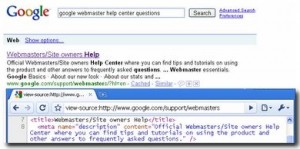
from http://googlewebmastercentral.blogspot.com/2009/09/google-does-not-use-keywords-meta-tag.html , July 2011
Are Meta Tags helpful? Meta tags are usually used for Search Engine Optimization and are thought to help web crawlers index your pages more accurately. Although at one time Meta tags held tremendous value for website ranking they no longer carry the same importance. Over time, less and less weight has been assigned to Meta tags due to their manipulation and user abuse. Eventually websites began to perform keyword stuffing (excessive use of keywords) and listed irrelevant information in their Meta tags to try to attract and mislead traffic to their pages. As users caught on to the black hat SEO techniques for Meta tags the search engines started to divert their attention and place more emphasis on actual content. Shifting their focus allowed the search engines to evaluate web pages appropriately based on visible content rather than depending on a Meta tag to deliver accurate information.
Meta tags no longer play the same critical role in SEO as they once did, but that doesn’t necessarily mean that they are all worthless. It is believed that certain Meta tags can still generate greater… Read the rest
Tags: content, keyword, Meta, Meta Tag, Meta Tags, search, search engine, tag, tags, webrank
Posted in Search Engines, Web Development | No Comments »
Friday, July 22nd, 2011
In February 24, 2011 Google introduced its new method for evaluating the quality of a website. Google Panda or “The Panda Algorithm” affected a little under 12% of search results and drastically reduced page visitors for many websites. At first 12% may seem like a small percentage but when considering the size of internet the figure becomes fairly significant. Google released Panda 2.0 in April and followed with version 2.1 in May. According to Search Engine Land Google had also just recently released its newest version (Panda 2.2) sometime during June.

from http://www.google.com/logos/logos11-2.html, July 2011
The Panda version 2.2 updates are thought to be the source behind the recent fluctuation in search listings and PageRank. Whether you experienced this change back in February or the new update is finally catching up with you, Google Panda seems to be impacting a tremendous number of websites and site owners across the Internet.
Although it is commonly called the Panda Algorithm, Google Panda is more of an individual Ranking factor rather than an entire new algorithm. Google uses a number of different factors when assigning a rank to a website. These factors are continually tweaked in order to provide the best user experience and return the most relevant search results. Search Engine Optimization (SEO) focuses on these evolving factors in an effort to increase site traffic and conversion rates. Although Google makes these adjustments to its ranking algorithm on a regular basis they usually go unnoticed or cause minor changes for most websites. However there have been a few major exceptions similar to the Google Panda update such as the Mayday Update of last year and the Vince Update in 2009.
How does Google Panda work? Google Panda acts as a filter to identify low quality pages. According to Matt Cutts the Panda Filter is not running all the time. Instead Panda performs periodic scans that occur during… Read the rest
Tags: Google, google pagerank, google panda, PageRank, panda, panda update, panda version 2.2, rank, ranking algorithm, update
Posted in Google, Search Engine Optimization SEO | No Comments »
Thursday, June 16th, 2011
Eliminating the barriers that stand between users and information is an endless goal for Google. The company continues to revolutionize the way users search the internet and strives to provide only the most relevant and superior content possible. On Tuesday June 14, 2011, Google held a media event in San Francisco to announce their new features that they hope will drastically change how users will search the internet. Among the features that were announced were Instant Pages, Search by Image, and Voice Search.
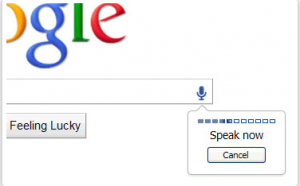
from http://www.google.com/insidesearch/voicesearch.html, June 2011
At the event Google also shared their latest search statistics. The stats showed that mobile search is following the same usage pattern as the early years of Google desktop search. Within the past couple years mobile searching has grown tremendously and with technology like voice recognition, mobile searching is expected to grow even more. Google believes that voice recognition is a technology that shouldn’t be limited to the mobile experience and that is why Voice Search is now available on a desktop. Their voice recognition is currently comprised of over 230 billion words or phrases and each day their system captures over 2 years’ worth of voice searches.
Voice search allows users to effortlessly speak what they are looking for and Google will find it, searching doesn’t get any easier than that. Voice search also helps out when users need to perform searches that are longer, more complex or harder to spell. Google Chrome 11 or higher and a microphone are required to use Google Voice Search. From there, voice searching is as easy as clicking on the small microphone button located by the search bar and speaking your search terms.
Another feature that first staked its ground on mobile devices was Google Goggles. Google Goggles allows users to search by snapping a picture with their mobile device. Google search now lets users search places, art, and animals using images on desktop computers.… Read the rest
Tags: Chrome, Google, Google Chrome, Mobile, search, Search Results, voice recognition, voice search
Posted in Browser Modifications, Search Engines | No Comments »
Wednesday, June 8th, 2011
Back in March Google began rolling out their +1 feature locally on their Google results page. The new feature enables users to activate the Plus 1 button when they wanted to recommend a website to other users. Since Facebook did not want to have their Like Button located on the Google search results page and chose to showcase it on Bing instead, Google has taken action and created its own way to boost social interaction. Similar to the Facebook Like Button, the plus 1 feature lets users put their stamp of approval on a website.
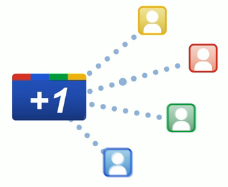
From http://www.google.com/+1/button/, June 2011
Exactly one week ago on June 1, 2011 Google announced that they are now offering the +1 button to website developers to place on their own content. On the day of the announcement the +1 buttons started appearing on major websites like Bestbuy.com, TheHuffingtonPost.com, and Nordstrom.com. After only a week the button now appears on large and small websites all across the Internet. Websites can display the button and enable people to recommend their website, blog or even individual products. Already the Google +1 feature seems to have a solid foundation but it continues to work towards being as widely used as its Facebook counterpart. From what we can tell here at Internet Beacon, the Google +1 button is being used frequently on the search results page but doesn’t quite yet have the exposure necessary to properly compete with the Facebook and Twitter sharing buttons that are on individual websites. In time this could change drastically, after all the button is only a week old.
It makes sense that Google would eventually assign some sort of values to this feature where the more plus ones a website has would equal a rank better, however it is still unclear how this development will affect SEO and the Google website ranking algorithm. Google could determine that sites who… Read the rest
Tags: +1, Google, Google Plus 1, search engine, Search Results, seo, social networking
Posted in Search Engine Optimization SEO, Search Engines, Social Networking | No Comments »
Friday, May 13th, 2011
Recently Google has begun testing a new search engine results page (SERP) with a limited group of Google users. It is unknown what criteria Google used to determine which users were given this opportunity and because there is no opt in for testing most users can only experience the new page via screenshots.
It remains unclear whether or not Google will further expand this sample testing or even continue in the same direction once they acquire usability feedback. Due to the limited testing being fairly recent no real results have been released other than the initial feedback from users that the new page is ugly or that it looks better, which really depends only on the users taste and not the designs usefulness.
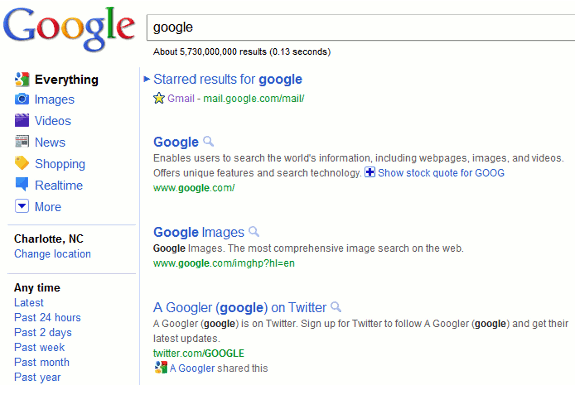
From Google, May 2011
For the users that were not selected to participate in the new  search results page trial you can view the changes at Google’s New Search Interface. As you can see from the screen capture it seems that Google has eliminated or scaled down the amount of information provided for each search result. The text has also decreased in size and appears cleaner with more white space. The older results page features a darker blue, green, and purple text color whereas the new page showcases brighter but muted pastel colors. The new colors go a long way to make the page look prettier but don’t offer the same contrast as the old page and instead can make it harder for some users to view because the bright on white color scheme. In addition there is also less page identification because the page title is no longer underlined. search results page trial you can view the changes at Google’s New Search Interface. As you can see from the screen capture it seems that Google has eliminated or scaled down the amount of information provided for each search result. The text has also decreased in size and appears cleaner with more white space. The older results page features a darker blue, green, and purple text color whereas the new page showcases brighter but muted pastel colors. The new colors go a long way to make the page look prettier but don’t offer the same contrast as the old page and instead can make it harder for some users to view because the bright on white color scheme. In addition there is also less page identification because the page title is no longer underlined.
Whenever there is a change with Google we have to ask how will this impact Search Engine Optimization? The main concern with this trial SERP is with the increase in white space between search results. Although the page certainly looks cleaner, the insertion of more space creates… Read the rest
Tags: Google, Internet Marketing, results, search engine, Search Results, SERP, Testing, user
Posted in Search Engine Optimization SEO, Search Engines | 2 Comments »
Friday, April 8th, 2011
Released to a limited number of users on April 2, 2011 and later expanded for the remaining Google account users, Google +1 has introduced another way for users to recommend websites and share their preferences with the rest of the web.
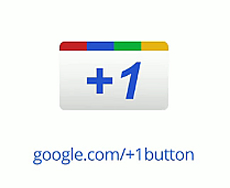
Google +1
from www.google.com/+1/button
April 2011
The Plus One (+1) feature is not an entirely new concept and is very similar to the “Like” button on Facebook. The major difference seems to be the service’s name and the primary platform which it is utilized on. Similar to Facebook, users can use the +1 option to show that they recommend a website, both on Google as well as on the websites that provide the Plus One option through a widget. In order to take advantage of this new feature a user will need to create a Google account.
Once a user establishes a Google account they can begin selecting the +1 option that appears below each of the search results. After a user has placed their stamp of approval on a listing via the Plus One option, it will appear on a new tab in their Google profile. This newly created tab is where a user is able to manage all of the elements that they have chosen to +1. These options include the ability to remove a recommendation and to choose who has the authority to view the items that you have marked as Plus One. The +1 feature enables you to choose whether the +1’s (recommendations) are private, public, or customized to grant permission to specific users.
If a user decides to keep their Plus One item private they will still be added to the number of people who recommend the site however their profile name will remain hidden. For example below a search result it will display “54 people +1’d this” as opposed to their user name plus the number of other people who have chosen the Plus One option. Users will be able to… Read the rest
Tags: Facebook, Google, Google +1, like, search, search engine, search result, user
Posted in Internet Marketing, Search Engines, Social Media Marketing | 1 Comment »
Wednesday, March 16th, 2011
Google’s Blog recently announced a new method for customizing their user’s search experience, which will be available soon.
March 15, 2011 from http://googleblog.blogspot.com
Recognizing that the search results they provide may not be a perfect match, Google is now providing a search site-filter. Initially, Google released this feature as a part of their Google Chrome web browser in January 2011. Seeing that about 15% of Internet users browse using Google Chrome, Google recognized the benefit of offering this feature in their search engine in addition to Google Chrome (see Chrome market share).
Providing this personalized site-filtering feature enables users to avoid unrelated information and block undesirable websites from appearing in their search results. Whether it is because the website is offensive, low quality, or if a customer just doesn’t like it, they now have the option to exclude it from their search results. This feature is now available for people using Google Chrome version 9+, Internet Explorer 8+, and Firefox versions 3.5+ Internet browsers.
Search Results
Although this feature provides customers with a better search experience, could this be used to determine the future rank of a website? In their blog, Google states that they may eventually evaluate and use the data from this feature as a signal for ranking. Presently they are only attempting to offer customers an easy and more controlled search tool.
How It Will Work
When using a compatible browser the person performing the search will notice a “Block all example.com website results” next to the “cached” and “similar” links. These links are located next to the websites URL following the description. After receiving a confirmation request to block the site the results will be hidden until the user decides to deactivate the block. Once blocked, if the search results contain a blocked website a message is then displayed to the user stating some of the results have… Read the rest
Tags: browser, Chrome, filtering feature, Google, internet, results, search, site blocking, website
Posted in Browser, Search Engines | No Comments »
|